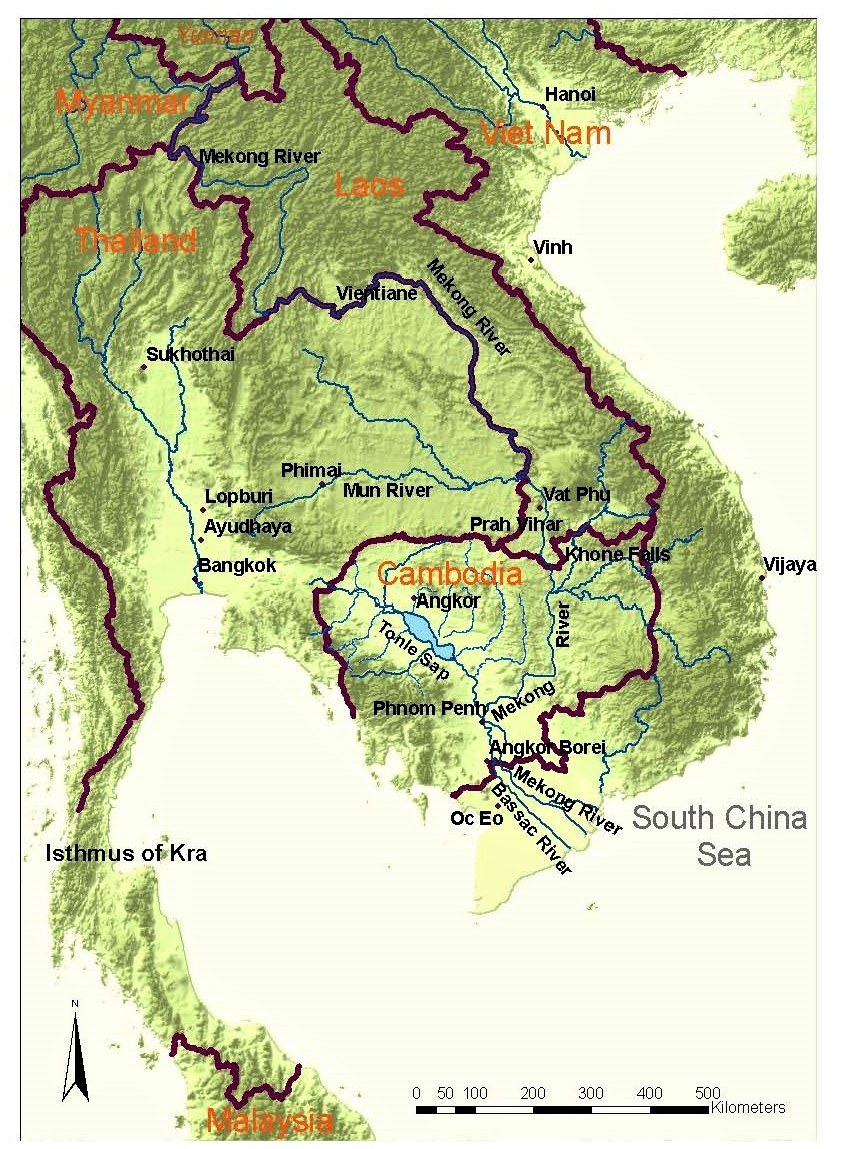Power and Pragmatism in the Political Economy of Angkor
by Eileen Lustig
A broad study of politics, economics and the specificity of the Angkorean State.

Publication: PhD Thesis, University of Sydney, Australia
Published: 2009
Author: Eileen Lustig
Pages: 282
Language : English
This PhD. thesis, far from the aridity of many academic essays, helps us gaining a vivid image of what the emerging Khmer Empire, particularly from the 9th to the 11th century, looked like.
Amongst the many insights developed by the author, we shall stress the following ones:
Primitive amalgamation of territories and Empire building: 'The first part of the 9th century can be seen as a new period of consolidation of royal power, centred for the most part on Angkor. At some stage after the turn of the 9th century, the amalgamated territories were consolidated into an empire. Jayavarman II’s successors, including Indravarman I (877-889) and Yaśovarman I (889-910), appear to have been concerned with consolidation of the dynasty’s power base. Yaśovarman, who moved the capital to the Angkor area following a dispute over the succession, is not known for any conquests, but was responsible for numerous monuments: hill sanctuaries near Angkor, the temple at Preah Vihear and many recorded, though as yet unidentified monasteries throughout his territories. A decade or so after his reign ended, Jayavarman IV (928–941) and Harṣavarman II (941–944) apparently ruled from a new capital which arose at Koh Ker, with the role of the king apparently continuing in essence as before — given the acknowledgment of Jayavarman IV in an inscription produced in far away Takeo Province.' (p.237)
Regional elites and central power: 'The rulers’ support of the regional elite through the immunities granted and permissions to amalgamate foundations could not be without consequences, and at least some of these privileges did not continue. The strategy of granting immunities, while initially successful, appears to have ultimately failed, as revenue was increasingly diverted from the centre. As the officials gained in wealth and power, relationships between competing elites and with the centre were at times unstable, potentially threatening the power of the rulers — who appear to have taken steps to reassert authority. Tightening central controls and/or some restructuring of the administration are two means of addressing the problem. In this instance, both actions may have accompanied the change of dynasty in 1080. The subsequent cessation of immunities to foundations, elucidated in this study, and loss of status of some titled officials could be considered as moves to reduce the threats to state revenue and power in the medium term.' (p. 249)
Why did Angkorean power never develop a monetary system? 'An absence of money and the lack of evidence of a unit of account, together with the long lists of barter items in the inscriptions, were interpreted by some as demonstrating the Khmer’s lack of development of monetary concepts, taking the many barter items of the temple inscription transactions as representing the whole economy. Although it can be said that other states more engaged in international trade were more likely to use money, none in the region, including active trading states such as Java, were fully monetised during the Angkorian period. It cannot be ascertained if the absence of money in the Angkorian period was a deliberate choice of rulers, the result of reluctance to change, or whether circumstances were such thatthe changes would have brought little benefit to elites or the state. Angkor could be viewed as being towards the low end of a continuum of monetisation. Arguably there were markets in regional centres for high value goods, where prices were negotiated, using a unit or units of account. Despite a primarily inland agrarian economy after the Funan period, trade appears to have been continual.' (p. 255)
Religion and politics: 'Khmer religious practices had developed from the integration of Indian religious concepts with the indigenous cults. As a result, indigenous cults could be incorporated into the official pantheon with relative ease, and royal deities could be shared with regional populations, facilitating the transfer of state ideology through the medium of religious symbolism. A model proposed by Sedov and Hall posits a hierarchy of temples and their deities linked through the practice of joining foundations, noted in several Pre-Angkorian and Angkorian inscriptions. The amalgamations, at least in origin, appear to have been more symbolic than practical. Nevertheless, the expressions used to describe this practice and occasionally the quantities of resources transferred in the Angkorian period suggest more than symbolism. In the Angkorian period, the many deities which are joined to a Śivaliṅga are often named or located at Liṅgapura and have indigenous titles, commonly containing the term jagat.' (pp 233-34).
A typical or atypical State? 'Angkor was not fundamentally different from contemporary states in the region — with one possible exception, the employment of a hierarchical structure of joined deities and their temples in state integration. Matters said to differentiate Angkor have been assessed as stemming from colonial viewpoints of Cambodian society or from over-reliance on literal and culturally biased interpretations of the temple inscriptions, written by and for a small and elite portion of the society. The inscriptions did not talk about day-to-day matters, but they do inform us about the priorities of elites: royal patronage; the ruler’s power, and control over land and labour. While hierarchies and dependence on patronage were a strong focus of the inscriptions of the Angkorian period, these traits appear to have been similar to those in much of Southeast Asia.'

Tags: Khmer Empire, economy, thesis, Khmer religion, state formation
About the Author
Eileen Lustig
Affiliate to the Department of Archeology at University of Sydney, Australia, Eileen Lustig has extensively studied the Angkorian economy and commerce through epigraphic research.
